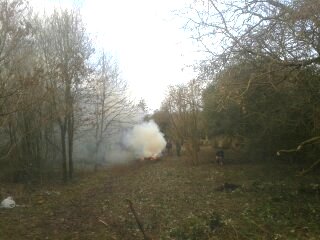Continuing this series of birdy posts about species recorded in the Filnore Woods bird survey which was published on this site on 26th November.
Have you ever noticed a huge bird sitting hunched on a roadside fence post and thought "I've just seen an eagle!" ?
I have. But in the south-west of England it's much more likely to be a buzzard.
I have. But in the south-west of England it's much more likely to be a buzzard.
The usual way I notice them is the rather plaintive flight call sometimes called mewing. It goes down in pitch towards the end, which gives it it's sad feeling. It's a bit like that bird of prey you hear in cowboy films - a sure sign that "someone's gonna die today."
When you hear the cry look up and you will probably see the buzzard soaring on air currents with its wing spread wide and motionless in a shallow v-shape. Occasionally you may see crows or gulls mobbing the buzzard in the sky. They don't like birds of prey.
Someone probably is gonna die when you hear that cry, but it will most likely be a vole or possibly a rabbit
Field vole from Devon Wildlife Trust
Buzzards do also take humbler fare like insects and earthworms. This is why they like to hunt over grassland although they nest in tall trees. You don't get field voles without fields. So a combination of woodland and grassland such as we maintain at Filnore Woods, is an attractive habitat for buzzards.
Field vole from Devon Wildlife Trust
Buzzards do also take humbler fare like insects and earthworms. This is why they like to hunt over grassland although they nest in tall trees. You don't get field voles without fields. So a combination of woodland and grassland such as we maintain at Filnore Woods, is an attractive habitat for buzzards.
They usually eat their prey on the ground.
They are also partial to pheasant chicks, which has given rise to a bit of controversy. Gamekeepers want the ever increasing buzzard population controlled, while organisations like the RSPB say no bird of prey should be shot or poisoned for sporting reasons. I think there is a middle way. I'm definitely not a fan of pheasant shoots but they do ensure that some wild country is conserved. And the explosion in the population of buzzards may be in some way related to human activity. We are part of the natural scene.
But when you hear that imperious cry and see that noble bird soaring like our equivalent to the condors of the Andes, you have to feel privileged and glad that they are there.
For opposing views on buzzards and pheasant chicks look at the Countryside Alliance's website, RSPB and George Monbiot's blog for 24th May on the guardian website.
Google 'buzzards and pheasants' and on page two there is a jolly good (haw haw) forum for gun dog owners http://workinghprs.myfastforum.org . I won't make a comment. Read it yourself.
For opposing views on buzzards and pheasant chicks look at the Countryside Alliance's website, RSPB and George Monbiot's blog for 24th May on the guardian website.
Google 'buzzards and pheasants' and on page two there is a jolly good (haw haw) forum for gun dog owners http://workinghprs.myfastforum.org . I won't make a comment. Read it yourself.



















